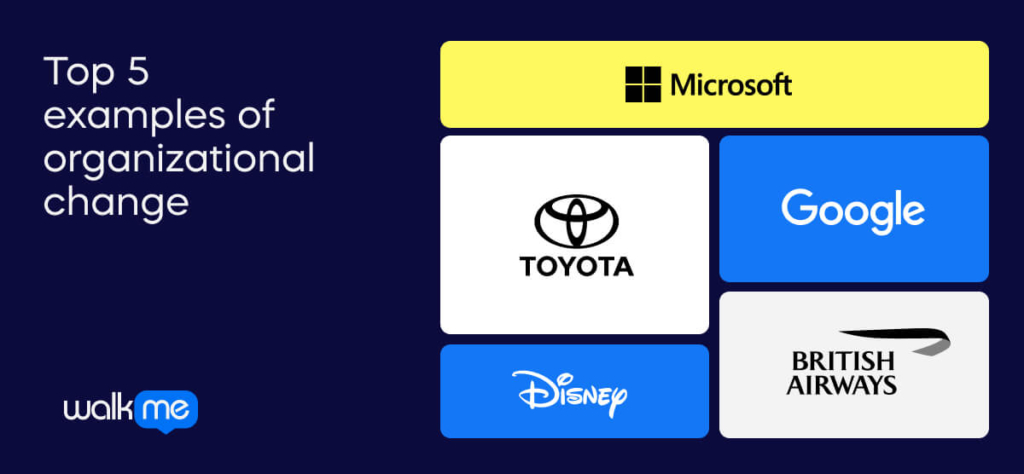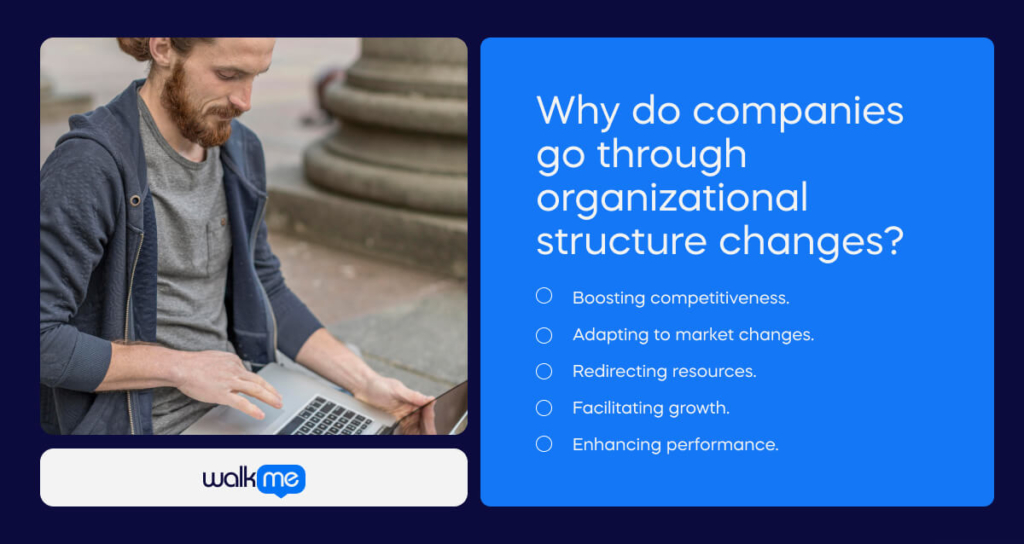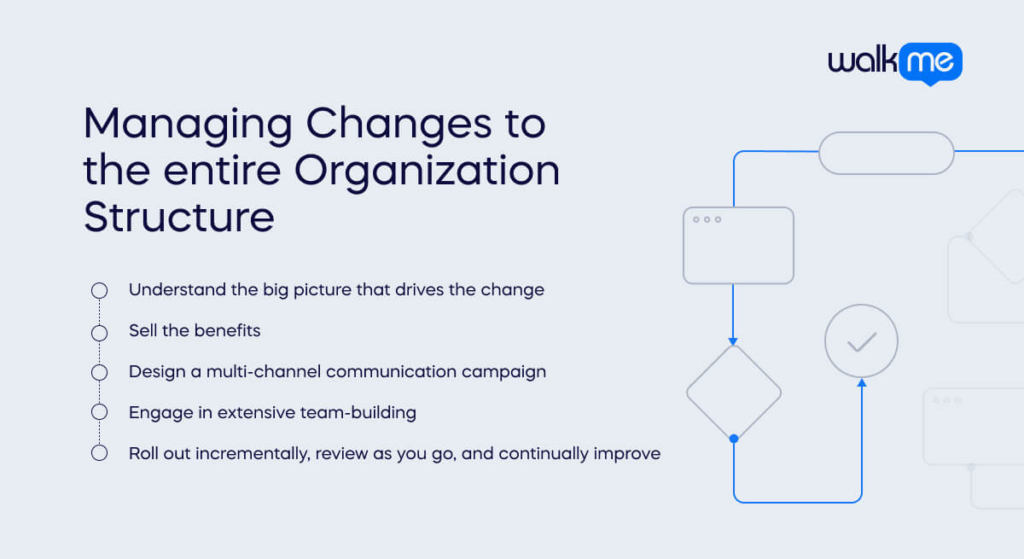Changes to organizational structure have ripple effects across a wide variety of business functions. The broad impacts of these changes make change management essential. Failure to manage these changes can result in pushback from employees, damage to core business metrics, culture clashes, and high levels of Uncertainty.
On the other hand, managed change can garner significant returns in organizational performance, such as decreased costs, improved morale, Lower failure rates, and reduced employee frustration and resistance. As with any other change management project, a sophisticated, well-structured approach is the key to success.
Change management adoption should begin with a comprehensive understanding of the drivers behind the change. A thorough review should be undertaken to identify all stakeholders, determine their needs and objectives, and estimate the cost of change.
The project team should develop an action plan that includes timelines, processes, and metrics based on solid change management principles.
Organizational structural change often results from financial or emotional turbulence in the workplace.
For example, McKinsey reported that in the wake of the COVID-19 pandemic, over 90% of companies expected to see more structural change projects in the coming years.
Although no two projects are the same, the experience of companies can be beneficial. This article will briefly overview organizational structure change before describing five prominent examples of corporate structure change projects.
Top 5 examples of organizational change

Examples of organizational structure changes provide insights into best practices and lessons learned from others who have undergone similar processes. By studying successful and unsuccessful restructuring efforts, change agents can identify common challenges and practical solutions we can apply to our projects. Additionally, understanding the motivations, strategies, and outcomes of different restructuring efforts can help us to better understand what might work best in specific business situations.
Going through structural change is one of the biggest challenges in effective organizational change management. The following five examples show that it can be done – even for complex and mature organizations.
- Microsoft under Satya Nadella
Satya Nadella’s restructuring of Microsoft aimed to eliminate internal competition and unite the company’s employees around a common goal. Upon taking the CEO role in 2014, Nadella implemented a new organizational structure focusing on reinventing productivity and business processes, building an intelligent cloud platform, and creating more personal computing.
The formation of the AI and Research Group by merging several teams was a key move in this restructuring. This move brought many engineers and computer scientists together to focus on artificial innovation across all Microsoft product lines.
Nadella’s restructuring also brought a new mission for Microsoft employees to “empower every person and every organization on the planet to achieve more.” This new mission brought the employees a sense of purpose and direction and improved morale and employee engagement.
- Toyota’s decentralization supports safety improvements
Toyota’s divisional organizational structure underwent significant changes in 2013 in response to the safety issues and related product recalls that started in 2009.
The previous structure was criticized for its slow response times to address safety concerns due to its strong centralized global hierarchy, which was more like a spoke-and-wheel structure with all major decisions being made at the company’s headquarters in Japan. All individual business units did not communicate with each other, and all communications had to go through the headquarters.
However, after the 2013 reorganization, Toyota’s new organizational structure has three main characteristics: a global hierarchy, geographic, and product-based divisions. The company maintains its global hierarchy but has increased the decision-making power of regional and business unit heads, leading to less centralized decision-making processes.
All business unit heads still report to Japan’s global headquarters. This new structure aims to improve response times and communication between different units, leading to better decision-making and addressing safety concerns.
- Google becoming “alphabet” to enhance innovation
In 2015, Google restructured itself into Alphabet, a conglomerate with several subsidiaries, including Google. The restructuring suited branding, positioning, and profit and loss reporting.
Google’s restructuring as Alphabet has had several effects. Firstly, it created a more focused structure, with Google as a subsidiary, allowing for more transparency and accountability for the various businesses under Alphabet.
Secondly, it helped the company diversify its revenue streams, creating separate companies for various businesses and ventures, such as Google, Waymo, and Verily.
Thirdly, the restructuring allowed for better management of the different companies, as each had its own CEO and management team. Overall, the restructuring of Alphabet has improved the structure and organization of Google’s various businesses, allowing for better growth and success in the long term.
The restructuring of Google into Alphabet was a strategic move that allowed the company to retain top talent, create internal competition, and separate its high-potential ventures from the parent brand. The restructuring has the potential to boost innovation and entrepreneurship within the company.
- British Airways cuts staff in the 1980s
British Airways underwent a significant restructuring effort in the 1980s, a crucial turning point in the airline’s history. The 1980s were a difficult period for the airline industry globally, and British Airways faced numerous challenges, including high fuel costs, intense competition, and a struggling economy. British Airways realized it needed to take action to survive and remain competitive.
In the early 1980s, British Airways launched its “Building for the Future” program to restructure the company, reduce costs, and improve efficiency. The program involved the introduction of new technology and automation, the closure of underperforming routes, and the reduction of staff. British Airways also sought to improve its image and customer service by investing in new aircraft and improving in-flight amenities.
The restructuring efforts paid off, and British Airways emerged in the 1980s as a much stronger and more competitive airline. The company’s financial performance improved, becoming one of the world’s leading airlines. The changes during the restructuring set the stage for future growth and success, and British Airways remains a significant player in the global airline industry today.
- Disney is shifting its focus to streaming
In 2021, The Walt Disney Company underwent an organizational structure change to streamline its operations and prioritize its streaming services and direct-to-consumer business in response to the growing impact of the COVID-19 pandemic on its traditional media and entertainment businesses. The restructuring involved consolidating specific business units, eliminating some positions, and realigning resources to support the growth of Disney’s direct-to-consumer offerings, such as Disney+.
The impact of Disney’s 2021 restructuring is not entirely clear, as the restructuring is still ongoing, and its full effects may not be fully understood for some time. However, some of the expected outcomes of the restructuring include increased efficiency and cost savings, a sharper focus on key growth areas such as streaming and international markets, and the realignment of certain business units to better support the company’s overall strategy.
The restructuring is also expected to significantly impact the company’s workforce, with many layoffs and other anticipated reductions as part of the cost-saving measures.
Why do companies go through organizational structure changes?

The cause of a company restructuring can vary depending on the organization. Generally, it is triggered by internal or external factors that change the company’s environment. These changes may include decreased market demand, new customer expectations, changing technology, and shifting economic trends. Companies may also restructure due to corporate mergers, acquisitions, or other strategic initiatives.
As such, they might decide to go through such a change for one of the following reasons:
- To become more competitive in the market by reducing costs, improving efficiency, and developing new strategies.
- To adjust to changing customer needs and preferences or to meet the challenges of a rapidly changing economic environment.
- To shift resources away from non-essential or underperforming activities into areas that are critical for success
- To provide opportunities for growth and expansion by introducing new products, services, or processes.
- To improve overall performance by focusing on core job functions, streamlining operations, and reorganizing the organization’s structure.
Managing Changes to the entire Organization Structure

Whenever an organizational structural change occurs, staff are likely to worry about their security, job structure, and well-being. Even when a company undergoes mass hires, existing staff can feel threatened by new employees. The following suggestions give some clues to moving to a new company structure without problems.
1. Understand the big picture that drives the change.
A merger, for example, can be considered a cause of restructuring.
But go deeper
- What caused the merger?
- What market conditions fueled it?
- Who made the decision and why?
This information may seem irrelevant or beside the point, but it’s not.
Understanding the real reasons behind change is essential for a few reasons:
- Knowing the cause of a change helps you restructure appropriately. Restructuring an organization is no small feat – deep analysis of the cause can include everything from market analysis to understanding business intelligence. This will inform and improve the final structure you design.
- You can explain these reasons to employees. As we’ll see below, explaining the “why” of change significantly improves support and lowers resistance.
- Your change project depends on in-depth information. A well-built change project requires reliable, thorough knowledge. A big-picture analysis will help you design effective roadmaps to change and overcome obstacles.
These are just a few reasons to analyze the causes behind change.
2. Sell the benefits.
Employees want to know what’s in it for them. After all, every change project requires more work, time, and effort. Organizational restructuring projects are even more daunting. Employees have to:
- Integrate into new teams
- Start from scratch when it comes to relationships and office politics
- Learn new skills and workplace dynamics
- Adapt to new workplace cultures and atmospheres
In some cases, restructuring a workplace is like changing jobs for everyone at the same time.
To reduce stress and resistance, sell employees the benefit of the restructuring.
Explain how it benefits the organization, team, and person.
3. Design a multi-channel communication campaign.
Communication is critical during any change project. It can be even more important during volatile restructuring projects.
To counter the negative emotions produced by this uncertainty:
- Communicate the causes for the change program in depth. Explain why it’s happening and the negative effects of not changing.
- Start early and finish late. Start employee onboarding well in advance of the change. The earlier you start, the easier it is for people to adjust.
- Invite total participation and create feedback mechanisms. Don’t just encourage feedback. Proactively solicit it. This will help you identify resistance and diffuse it.
- Create a multi-channel campaign. An email blast or a meeting is not enough. Create multiple online and offline resources so everyone can engage with your project at their convenience.
Make sure that leaders also get involved.
The more open, transparent, and democratic the process, the more involved the people.
4. Engage in extensive team-building.
A new organizational culture needs to be built.
One way to do this is through communication campaigns, as mentioned above.
Another way is through team-building, such as:
- Social Events – Social events are a good way to break the ice and introduce new group dynamics. Starting with social events helps people initiate relationships without thinking about work.
- Meetings and Workshops – Work meetings help people “dip their toes into the pool” by introducing new dynamics without plunging them headlong into the new work environment.
- Team-Building Exercises – A company should also consider team-building and change management exercises. Unlike social events, they compel people to work together as a team … which they will inevitably do once the restructuring is underway.
As change managers know, a stage-based approach is essential to gaining employee support.
Team-building activities such as these can help employees feel at ease, which will decrease frustration and stress.
5. Roll out incrementally, review as you go, and continually improve.
Incremental rollout is a feature of any change management project.
That is, every element of a change project should be introduced gradually.
There are a few reasons for this:
- Smaller changes are easier to implement than larger ones
- It reduces shock, stress, and resistance to change
- Relationships take time to develop – giving people time to prepare, even mentally, helps them adjust early on
- Incremental rollout enables you to learn at each stage and then incorporate that information into the next rollout
A stage-based project roadmap will help you clarify goals for each stage. Then, based on the results of that point in the journey, the change leaders can make adjustments before the next step in the project.
Don’t be afraid of major Organizational Change Initiatives
Under every successful business reorganization, a detailed change process determines every company’s decision. This article has focussed more on the outcomes than the internal processes that lead to those outcomes.

As a 2020 blog post from Gartner advises, a business cannot simply transplant a solution from another company: they must “diagnose the root cause of problems that are affecting their business and design a plan to address each associated element.”.
In other words, every company must develop a strategic change program from scratch.
The success of others inspires successful companies without being seduced by flashy outcomes from changes to an organization’s structure. Successful organizational change will depend on the corporate culture, effective leadership, new technology, and more.

